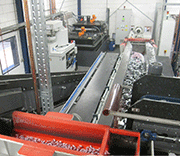E-Archive
Articles
in Vol. 14 - September Issue - Year 2013
Energy Saving Operation At 15 Percent Higher Parts Throughput

The new continuous feed linear mass finishing system R 425/4600 DA produces a 15% higher parts throughput

Mass finishing system R 425/4600 DA in operation. In the background, centrifugal filter and processing tanks.
By investing in a new continuous mass finishing system from Rösler, an internationally renowned cutting and stamping company was able to not only increase its parts throughput by around 15% but, at the same time, was also able to reduce its finishing costs.
The Wolfgang Loch Company specializes in the manufacturing of tools, prototypes and precision metal parts. Its production program consists of more than 1500 stampings and assemblies. These parts are predominantly used in automotive safety components, but they can also be found in domestic household appliances and in medical devices. The company has three manufacturing locations in Idar-Oberstein and one in Brazil.
Focus On Capacity, Equipment Availability And Operating Costs
Until a few years ago, the continuous surface finishing of industrial parts in so-called "continuous feed mass finishing systems" was more or less limited to the treatment of die-castings. Due to the continuous technical improvements of both equipment and grinding media, today numerous stampings and fine blanked parts undergo a finishing process in continuous mass finishing systems for breaking sharp edges and removing loose burs. This important manufacturing step not only improves the assembly and handling characteristics of the parts, but also contributes significantly to the mechanical reliability and overall safety of the end products.
Within the framework of a capacity expansion project in 2011, Wolfgang Loch also purchased a new mass finishing system from Rösler. Key requirements for this finishing system were high parts throughput, high equipment availability, energy-saving operation, and the optimal integration into the overall manufacturing flow. The project leader at Loch, Franz-Walter Esser states, "Our experience with Rösler mass finishing equipment has been excellent. We didn‘t even talk to any other equipment manufacturer." Because of its high performance and low operating costs, the continuous feed linear mass finishing system R 425/4600 DA turned out to be the optimum equipment choice. Esser continues, "The installation of the finishing system including a centrifugal filter and its integration into the overall manufacturing flow worked very well. Within a week-and-a-half, everything was fully functional."
Linking Of All Equipment Components Guarantees Fully Automatic Operation
After passing through a washing/cleaning system, the parts are continuously fed into the mass finishing system with a special conveyor belt. Depending on the parts size and how delicate they are, the hourly throughput can be as high as 2,640 lbs (1200 kg). The special cross-sectional design of the work bowl with its diameter of 17 inches (425 mm) and total length of 15.4 ft (4600 mm) results in an optimum flow of the work piece/media mass and a highly intensive finishing process over the complete work bowl length. Five equally spaced imbalance drive units, mounted below the work bowl, generate ample mass energy to prevent any "dead" zones anywhere in the work bowl. Depending on the parts type, the processing time can vary between 10 and 15 minutes. Franz-Walter Esser explains, "With the new line, we have achieved a capacity increase of 15 percent." The operator can easily adjust the parts specific processing times by a simple inclination of the work bowl. This work bowl inclination is controlled by multiple programs stored in the PLC of the main control panel. Compared to systems with a stationary work bowl, controlling the processing times by inclination of the work bowl has the additional advantage of ensuring a constant media level and a constant high processing intensity over the complete work bowl length, including the work bowl discharge section.
After the vibratory multideck tumbling and screening station where the finished parts and the grinding media are separated, the still-wet parts are transferred to a continuous hot-air belt drier. To reduce the drying time and energy consumption, the parts are passed through a high performance air blow-off station before entering the actual hot-air drying zone. Franz-Walter Esser expresses the customer expectations regarding the energy efficient design of the new mass finishing system as follows: "We estimate that our new system will help us reduce our energy costs for surface finishing by about 10%."
For Information:
Barbara Müller
Rösler Oberflächentechnik GmbH
Vorstadt 1
96190 Untermerzbach, Germany
Tel. +49.9533.924-802
Fax +49.9533.924-300
E-mail: b.mueller@rosler.com
www.rosler.com



























